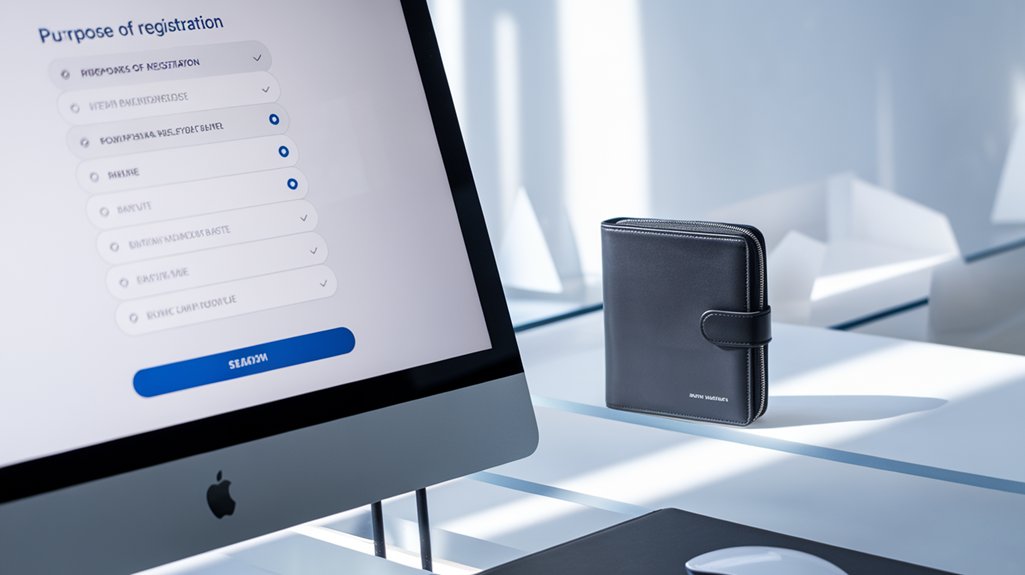Selecting the correct registration purpose in SAM directly impacts an entity’s eligibility for federal opportunities. Organizations must choose between “Bid on government contracts,” “Apply for federal grants or loans,” or “Request Unique Entity ID only” based on their federal engagement goals. Businesses seeking contracts should select “All Awards,” while non-profits pursuing grants should choose “Financial Assistance.” Incorrect selections cause processing delays and may block access to opportunities. Proper alignment of entity type with registration purpose guarantees seamless participation in the federal marketplace.
Understanding the Registration Purposes in SAM

When registering in the System for Award Management (SAM), entities must select the appropriate purpose that aligns with their federal engagement goals. SAM offers several registration options tailored to specific needs of organizations seeking to work with the government.
Entities pursuing federal contracts must select “Bid on government contracts,” which enables them to compete for procurement opportunities. Organizations seeking financial assistance should choose “Apply for federal grants or loans” instead. For those who only need an identifier without full registration, the “Request Unique Entity ID only” option suffices.
Selecting the correct SAM registration purpose unlocks specific federal opportunity pathways while preventing processing delays.
Existing registrants must select “Update existing registration” to renew their SAM profile annually. Organizations specifically receiving federal assistance like grants should choose “Register as a federal assistance recipient.” The system will display convenient green “Get Started” buttons to initiate the registration process in your workspace.
Selecting the correct purpose guarantees entities access appropriate systems and complete relevant documentation, preventing delays in the registration process and maintaining eligibility for federal opportunities. Proper registration is essential for small businesses to access set-aside contracts specifically designated for them in the federal marketplace.
How to Match Your Entity Type With Registration Purpose

Matching your entity type with the appropriate registration purpose in SAM represents a foundational step for successful government collaboration. The entity classification directly determines which registration option will provide the correct access to federal opportunities.
Business entities seeking contracts should select “All Awards” during registration, enabling them to bid on federal procurement opportunities. Non-profit organizations and state entities pursuing grants should choose “Financial Assistance” to access funding programs aligned with their missions. Federal agencies involved in internal transactions must specify “Intra-Governmental Transactions” to facilitate proper interdepartmental collaboration. Registration in SAM is completely free of charge, contrary to fraudulent claims requesting payment for this service. Remember that active SAM registration is mandatory for all federal business and funding applications.
The registration criteria vary based on entity type:
- Businesses require Unique Entity IDs and may need CAGE codes
- Non-profits must provide evidence of their tax-exempt status
- Government entities need to specify their department and authority
- Individual contractors must indicate their service capabilities
All entities must renew their registrations annually to maintain eligibility for federal awards. The federal compliance requirements ensure that all registered entities meet the standards necessary for receiving government contracts or assistance.
Common Pitfalls to Avoid When Selecting Registration Purpose

Maneuvering the SAM.gov registration process involves several potential obstacles that can delay or invalidate an entity’s application. Purpose misalignment represents one of the most consequential registration mistakes, occurring when organizations select incorrect classifications for their business type.
Accurate entity classification in SAM.gov registration prevents delays and ensures eligibility for targeted contract opportunities.
Organizations frequently select “Commercial Entity” inappropriately for non-commercial work, blocking access to specific contract categories. Successful registration requires DUNS number verification and accurate entity information submission to maintain eligibility for federal opportunities.
Another common error involves mistaking user account creation for completing entity registration, leaving businesses ineligible for contract consideration despite believing they’ve completed the process. This misunderstanding can lead to severe consequences as demonstrated by recent GAO decisions requiring continuous registration from proposal submission through award under FAR 52.204-7.
Registration mistakes also include:
- Selecting incompatible NAICS codes that limit visibility for relevant opportunities
- Incorrectly claiming socioeconomic program eligibility (HUBZone/WOSB)
- Misapplying Small Disadvantaged Business status without proper documentation
- Confusing non-profit designations with small business classifications
These purpose misalignment issues often trigger compliance audits and can result in rejected applications, delayed approvals, or post-registration penalties.
Frequently Asked Questions
Can Foreign Entities Register for Federal Grants Through SAM?
Yes, foreign entities can register for federal grants through SAM.gov.
Foreign eligibility requires obtaining an NCAGE code prior to registration and selecting “Foreign Owned and Located” as the entity type.
During registration, organizations must choose “apply for federal assistance opportunities” to access grant application functions.
Foreign entities need a Unique Entity Identifier (UEI) and must provide a Taxpayer Identification Number.
However, payment disbursements can only be processed through U.S. bank accounts.
How Quickly Does SAM Registration Information Transfer to Other Federal Systems?
SAM registration information transfers to other federal systems on varied timelines through data synchronization processes.
Most immediate electronic updates occur within 24-48 hours for systems like Grants.gov. Contract Opportunity listings update within one business day, while FPDS-NG takes 2-3 business days.
Factors affecting registration timelines include validation errors, data field mismatches, and system maintenance periods.
For best results, organizations should pre-validate all data elements and monitor the SAM Status Tracker for real-time updates.
What Happens if My Entity Type Changes After Registration?
When an entity type changes after registration, the entity administrator must update the SAM.gov registration to reflect this change.
Entity registration implications include temporarily maintaining the prior entity type until approval of the update. Registration type changes require full review, even for active or expired registrations.
This process may delay federal contract eligibility if entity type mismatches exist. The administrator should submit updated documentation that aligns with the new legal structure to avoid validation errors.
Are Temporary Extensions Available for Expired SAM Registrations?
Temporary extensions for expired SAM registrations are generally unavailable outside specific circumstances.
While SAM implemented a 30-day grace period in May 2022, this was a temporary measure, not a permanent policy. Organizations must renew registrations before expiration to maintain eligibility for federal contracts.
Even with timely renewals, processing delays can create activation gaps. Contractors should initiate renewals at least 60 days before expiration and monitor status daily near expiration dates to prevent lapses.
Can Multiple Divisions of One Organization Have Separate SAM Registrations?
Yes, organizations can establish multiple registrations in SAM for different divisions.
Federal regulations allow and sometimes require separate division registrations when different business units bid on contracts independently. Each division must obtain its own unique UEI through SAM.gov and maintain distinct registration records.
This approach guarantees compliance with federal contracting requirements while allowing the parent organization to maintain centralized management of its various divisions’ government contracting activities.